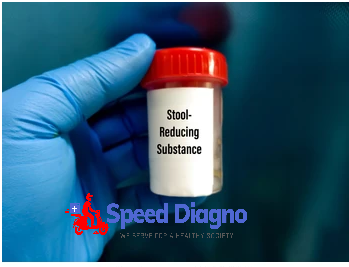- Home
-
Test Categories
- Diabetes
- Urinary
- Thyroid
- RTPCR
- Genetic
- Cancer
- Haematology
- Biochemistry
- Serology & Immunology
- Clinical Pathology
- Cytology
- Microbiology
- Endocrinology
- Histopathology
- MOLECULAR DIAGNOSTICS
- Pregnancy(Biochemistry)
- Liver
- Prostate
- Fertility
- Gastro
- Autoimmune Disorders
- Heart
- Kidney
- Vitamins
- Tuberculosis (TB)
- Anemia
- Fever
- Allergy
- Blood Tests Rare
- Profiles
- Packages
- About Us
- Why Choose Us
- Upload Prescription
- Corporate Wellness
- Contact Us

-
Overview
Reducing Substance Test (Stool) is a diagnostic test used to detect the presence of reducing sugars (such as glucose, lactose, fructose, and galactose) in the stool. This test is particularly useful in diagnosing carbohydrate malabsorption disorders, such as lactose intolerance, disaccharidase deficiencies, and conditions like congenital lactase deficiency. Elevated levels of reducing substances in the stool indicate that the sugars are not being absorbed properly in the intestines and are instead being excreted, often leading to symptoms like diarrhea, bloating, and abdominal discomfort.
Patient Preparation for Reducing Substance Test (Stool)
Fasting Requirements:
- Fasting: No fasting is required for this test. The patient can eat and drink normally.
Dietary and Medication Precautions:
- Normal Diet: The patient should continue a normal diet, including carbohydrates, before the test, as avoiding them may lead to false-negative results.
- Avoid Certain Medications: Avoid antibiotics, antidiarrheal medications, or laxatives before the test unless advised otherwise by your healthcare provider, as these may affect the results.
Sample Collection Process by Speediagno Phlebotomist or Technician:
Speediagno ensures a professional and sterile sample collection process for accurate detection of reducing substances in the stool.
Preparation for Sample Collection:
- Identify the Patient: The technician confirms the patient’s identity using at least two identifiers (e.g., name and date of birth).
- Consent and Explanation: The procedure is explained to the patient or caregiver, including clear instructions on how to collect the stool sample correctly.
Stool Collection Process:
- Collection Kit: The patient or caregiver is provided with a sterile stool collection container with a tight-fitting lid and instructions.
- Sample Collection:
- For Infants and Young Children: Collect the stool in a clean, dry diaper, plastic wrap inside the diaper, or a collection pad to avoid contamination with urine.
- For Older Children and Adults: Collect the stool sample in a clean, dry container, bedpan, or directly into the provided sterile container. Avoid contamination with urine, water, or toilet paper.
- Sample Amount: Collect about 1-2 tablespoons of stool, focusing on any liquid parts if present, as they are more likely to contain reducing substances.
Post-Collection Care:
- Labeling and Sealing: The stool sample container is sealed tightly and labeled with the patient’s details, including the date and time of collection.
- Transport: The sample should be transported to the laboratory promptly, preferably within an hour, to ensure accurate test results.
Safety and Hygiene Protocols:
- Proper Disposal: All used materials such as gloves and wipes should be disposed of in designated biohazard containers.
- Hand Hygiene: Wash hands thoroughly after handling the stool sample to prevent contamination and the spread of pathogens.
Laboratory Processing:
- Chemical Analysis: The stool sample is mixed with a reagent such as Benedict's solution or Clinitest tablets, which reacts with reducing sugars. A color change indicates the presence of reducing substances in the stool.
- Interpretation of Results: A positive result indicates the presence of unabsorbed sugars in the stool, suggesting a malabsorption disorder. Further testing may be needed to identify the specific type of sugar that is not being absorbed.
This comprehensive approach ensures accurate detection of reducing substances in the stool, aiding in the diagnosis and management of carbohydrate malabsorption conditions.
All test groups and subgroup
-
REDUCING SUBSTANCE
-
STOOL EXAMINATION, pH & REDUCING SUBSTANCES (Dipstick, Benedict)
-
pH
-
Reducing Substances
-
